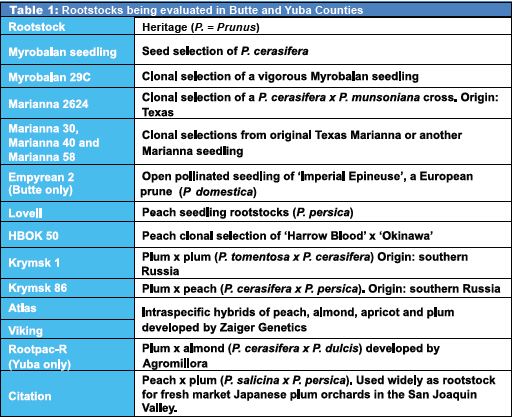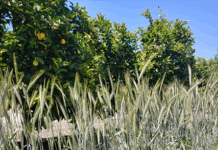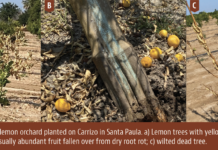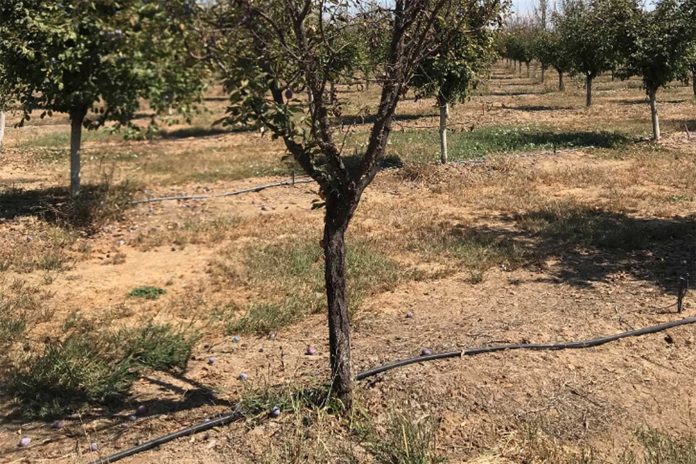
Roots are the unsung heroes of orchard plantings. They operate out of sight and are relatively difficult to examine and characterize. The roots of course anchor the trees to the soil and take up water and essential mineral elements. They also store carbohydrates and synthesize materials. Because roots play these key roles, rootstocks can influence scion vigor, growth and performance. Rootstocks vary in their tolerance to different soil types and conditions and their resistance to soil borne diseases and nematodes
As soil treatment options become increasingly limited, more restrictive and less effective, the priority to identify a genetic solution to solve or reduce the replant issue is of increasing interest. One genetic solution is to find or develop rootstocks to help manage soil related problems, such as soil borne fungi/bacteria, nematodes and soil acidity and excess salts. Of additional interest are root and tree characteristics imparting canopy size control, good anchorage and little or no root suckering.
The California prune industry has historically utilized just five rootstocks, Myrobalan 29C, Myrobalan seedling, Marianna 2624, Lovell peach and Marianna 40. The Prune Production Manual (UC ANR # 3507) has a very good chapter describing the traditional rootstock choices. You can find the production manual for sale at anrcatalog.ucanr.edu and as an e-version through Google Books. Recognizing the need for identifying additional rootstocks for California prune production, University of California farm advisors and campus-based faculty with funding from the California Prune Board designed and planted two replicated rootstock experiments in 2011 to evaluate 15 rootstocks for prune production. These rootstocks have diverse genetic backgrounds within the Prunus family (plum, peach, almond, etc.).
Replicated rootstock trials in growers’ orchards in Butte County and Yuba Counties allow UC researchers to evaluate a total of 15 rootstocks (Table 1, below) under very different soil, irrigation, and yield potential. The Butte plot is planted on Farwell clay adobe and the lighter textured Nord Loam soil types; this ground was previously planted to almonds on Lovell (peach) rootstock. In contrast, the Yuba site is planted on more typical prune ground (Kilga clay loam) and is prune following prune. The Butte site has tighter spacing at 12.5 feet in-row and 17 feet between rows (205 trees per acre), compared to 16 feet in-row and 18 feet between rows (151 trees per acre) at Yuba. The Butte plot is drip irrigated, while the Yuba plot has micro sprinklers. The differences in soil, crop history, tree density, irrigation, and resulting vigor at the two replicated trial sites allows for a rigorous evaluation of these rootstocks.
Tree Survival
Roger Duncan a pomology farm advisor based in Stanislaus County, who has done extensive trialing of rootstocks for almond production, has noted that rootstock choice is like an insurance policy. Although there is no perfect rootstock, careful rootstock selection can help guard against disaster. These two trial sites have illustrated an incredible range in rootstock survival, which helps illustrate a varying ability of these rootstocks to guard against disaster at two very different sites. Following a wet winter which delayed soil preparation in 2011, both the Butte and Yuba sites experienced extensive mortality and were significantly replanted in 2012. However, even after replanting in 2012, the rootstocks have experienced very different rates of survival.
Percent tree survival since the 2012 replanting was assessed at both sites in 2019 (Table 2, below). Survival ranged from 10 percent (Empyrean 2) to 97 percent (Atlas) at the Butte site, and 37 percent (HBOK 50) to 100 percent (Viking and Lovell) at the Yuba site. The two rootstocks that are only planted at a single site each have had dramatically different results, with the disastrous 10 percent survival of Empyrean 2 at Butte, compared to the 93 percent survival of Rootpac-R at Yuba.
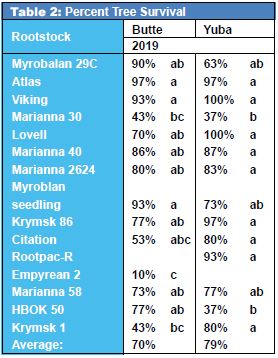
There are other notable differences and similarities in survival between the two sites. Myrobalan 29C, Myrobalan seedling, and HBOK 50 have all had higher survival rates at the Butte site, potentially due to bacterial canker susceptibility at the Yuba location. At both sites, Atlas and Viking, which were planted in 2012 (not available in 2011), have had excellent survival (97 to 100 percent). Marianna 40 and Marianna 2624 have also had decent survival (80 to 87 percent). Finally, Marianna 30 has had very low survival at both sites (43 and 37 percent at Butte and Yuba, respectively).
Bacterial canker susceptibility has greatly colored the results at the Yuba location. Land with a history of the disease likely has ring nematode, and may also have sandy or low pH soils, low tree nitrogen status, or a clay/shallow hardpan. For land with a history of bacterial canker, having a prune orchard with a high rate of survival at maturity is no small feat.
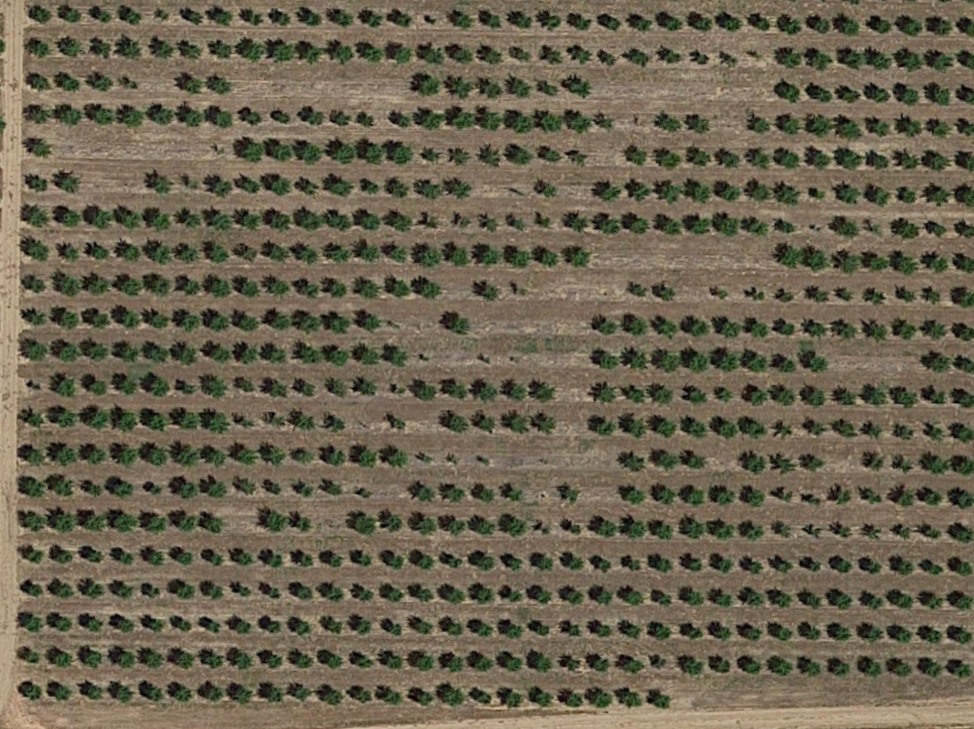
The satellite image of this plot clearly shows several gaps of missing trees that are six trees in length (i.e. the number of trees in a rootstock treatment replicate, see related photo). Although there are several causes of tree loss in the plot, certain rootstocks have had very low survival in the same areas of the orchard where other rootstocks have 100-percent survival and vigorous growth. For example, Myroblan 29C an industry standard, had a mere 63-percent survival as of 2019, while Marianna 30 and HBOK 50 fared even worse, each at 37-percent survival. In contrast, Viking, Atlas, Krymsk 86, Lovell and Rootpac-R all had between 93- and 100-percent survival.
Vigor and Yield
The first mechanical harvest in the two trials was in 2017 and yield data continues to be taken. In addition to the Butte site having tighter spacing (205 trees/acre, compared to 151 at Yuba), the tree trunks have generally been larger, and yields per tree higher than Yuba. The 2017 yield results at Butte offer a valuable glimpse into the vigor of these rootstocks, since it was a very high yielding and unthinned crop, which helps illustrate the yield potential of these rootstocks. These high, unthinned yields were unsustainable and in 2018 there was poor return bloom at the site and low yields.
The 2017 harvest at the Butte site shows that a larger trunk, measured as trunk cross sectional area (cm2), generally higher dry yield (pounds per tree), and smaller fruit size (table 3). Among the smaller trunk size and lower yielding trees were Krymsk 1, HBOK 50, Marianna 58, Empyrean 2 and Citation. Among the largest and highest yielding were Myrobalan 29C, Atlas, Viking, Marianna 30 and Lovell. Similar yield and trunk size differences between rootstocks have been found subsequently at both sites. Of course, all rootstock trials that impose the same spacing across the plot disadvantage lower vigor rootstocks that could have been placed at a higher density.
Although there are similarities in yield performance of the rootstocks at both sites, there are some notable differences between sites. Rootpac-R, which isn’t planted at the Butte site, has had middle of the pack trunk size and yield at Yuba. Another notable difference is that Krymsk 86 is a fairly average vigor and yield rootstock at Butte but is among the largest and highest yielding at Yuba.
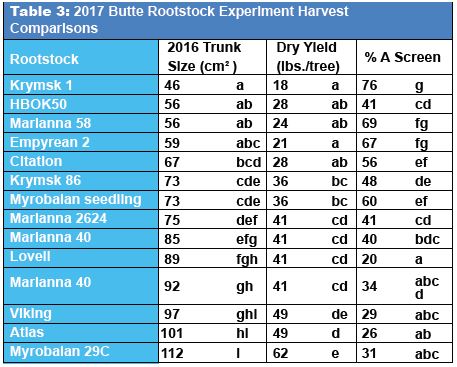
Anchorage & Suckering
In addition to survival and vigor (and resulting yield potential), there are other attributes that are important to growers. Anchorage is key since growers need trees to stand up on their own and not be blown over, as well as provide a straight up-and-down trunk for shaker harvesting. Degree of lean was measured with the level feature in the iPhone at both rootstock plots with one person pushing against the tree and another person measuring the deflection. Although rootstocks at the Yuba site had greater lean (there were notable wet soil conditions at the time of measurement), the rootstocks had similar relative lean to one-another at the two sites. Marianna 58 and Krymsk 1 had among the greatest angles of deflection, while Viking and especially Krymsk 86 showed little deflection at either site.
Removing suckers is a costly and cumbersome activity. In addition, rootstock suckers may offer a route for systemic herbicides to be taken up and damage the tree. Rootstocks suckers were rated on a one to five scale, with one being the fewest suckers and five being extensive and large suckers. Again, the two sites offered many similarities in rootstock performance. Myroblan seedling had the most rootstock suckers at both sites, while many rootstocks including Atlas, HBOK 50, Viking, Citation, Marianna 58, Lovell and Marianna 40 had few, if any suckers.
Rootstocks with Potential Problems
Many of the rootstocks haven’t performed well when survival, lean, and suckering were evaluated. Many of those same underperforming rootstocks also tend to be on the lower vigor and lower yielding end of the spectrum. Krymsk 1 and Marianna 58 had among the highest lean, and in-addition Krymsk 1 had low survival at Butte and was among the lowest yielding rootstocks. HBOK 50 also had high lean, poor survival at Yuba, and poor yield at Butte. Empyrean 2 which was only at Butte, had a mere 10-percent survival by 2019. Myroblan seedling had the worst suckering and had high lean at Yuba. The industry standard Myroblan 29C has performed well at Butte but has had low survival under the bacterial canker conditions in Yuba. Marianna 30, despite been among the highest yielding rootstocks per tree at Butte has had very low survival at both sites.
Rootstocks with Evident Strengths
Krymsk 86, Viking, and Atlas have all had very high survival at both rootstock trial sites. In addition, Krymsk 86 has been among the highest yielding at Yuba, and Atlas and Viking have been high yielding at both sites. Krymsk 86 has maintained its reputation for excellent anchorage, while Viking also showed little lean at both sites. Finally, both Viking and Atlas had a sucker rating of zero at both rootstock plots.
Where is Rootstock Selection in the Industry Headed?
Atlas, Viking, and Krymsk 86 have all shined at these two rootstock plots. Krymsk 86 is the only one of these that is so far seeing significant adoption in the prune industry. Following widespread adoption of Krymsk 86 in the Sacramento Valley for almond production, Krymsk 86, known for its superior anchorage and tolerance to wet feet, has been planted now in many new prune orchards. Like the higher vigor at the Yuba site and in contrast to the middling vigor at Butte, we have heard from growers that Krymsk 86 has been a high vigor rootstock in their plantings. Just as with growing almonds on Krymsk 86, growers should test for and be wary of planting Krymsk 86 where nematodes, particularly root-knot, are present.
As described in an article in the September/October issue of Progressive Crop Consultant (progressivecrop.com/2019/10/californias-prune-orchard-of-the-future) choosing a higher vigor rootstock and/or planting at a tighter spacing leads to capturing more sunlight and having a higher yield potential. However, when hand pruning large prune trees can cost $1,000 per acre, many growers are adopting mechanical hedging, and some progressive growers have had an increased interest in low vigor rootstocks. A couple of these growers have begun trialing low vigor inducing rootstocks in high density plantings, in hopes that low vigor rootstocks will reduce pruning expenses. Low vigor, high density and potentially trellised plantings, stand in stark contrast to the vigorous rootstocks that have stood out in these two trials. The choice between high and low vigor rootstock may prove to be one of the key defining choices where the California prune industry heads in the coming years.
We want to sincerely thank an amazing team of UC researchers, as well as support from dryer managers at Sunsweet Growers Inc. This work is made possible by the generous funding support of the California Prune Board.











